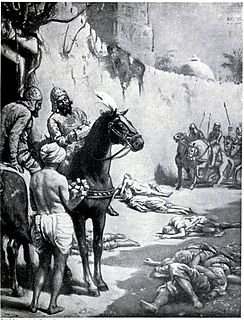무함마드 바흐티야르 할지
고르 제국의 통치자
이흐티야르 알딘 무함마드 바흐티야르 할지(파슈토어: اختیارالدین محمد بختیار غلجي, 벵골어: ইখতিয়ারউদ্দীন মুহাম্মাদ বখতিয়ার খলজী)[1] 또는 바흐티야르 할지[2][3]는 고르 제국의 통치자 무함마드[4]의 투르크-아프간[5][6] 군 장군으로, 동인도의 벵골과 비하르 지역의 이슬람 정복을 이끌고 통치자로 자리잡았다.[7][8][9][10] 그는 1203년부터 1227년까지 짧은 기간 동안 벵골을 통치했던 벵골 할지 왕조의 창시자였다.
|
무함마드 바흐티야르 할지
| |
|---|---|
 불교의 승려를 학살하는 무함마드 | |
| 벵골의 아미르 알무미닌 | |
| 재위 | 1203년~1206년 |
| 전임 | 신설 |
| 후임 | 무하마드 시란 할지 |
| 신상정보 | |
| 출생일 | 1150년 |
| 출생지 | 가르름시르 |
| 사망일 | 1206년 |
| 사망지 | 방가르 |
| 왕조 | 할지 왕조 |
| 종교 | 이슬람교 |
서기 1197년과 1206년 사이에 인도 아대륙에 대한 할지의 침입은 대량 이주와 불교 승려들의 대량 학살에 이르게 했고, 북인도의 전통적인 고등 교육 기관에 손상을 입혔다.[11] 벵골에서, 할지의 통치는 불교의 쇠퇴에 큰 영향을 끼쳤다.[12][13] 그의 통치는 벵골 술탄국과 벵골 수바의 통치로 이어지는 이슬람의 벵골 통치의 시작이라고 말해진다.[14]
바흐티야르는 1206년 불운한 티베트 원정을 시작해 알리 마르단과 미르자 하이데르 고니 파하드가 벵골로 돌아오자 암살당했다.[15][16] 그의 뒤를 이어 무함마드 시란 할지가 벵골을 다스렸다.
같이 보기
편집각주
편집- ↑ 〈Ikhtiyār al-Dīn Muḥammad Bakhtiyār Khiljī | Muslim general〉. 《Encyclopedia Britannica》. 2018년 9월 9일에 확인함.
- ↑ Faruqui, Munis D. (2005). “Review of The Bengal Sultanate: Politics, Economy and Coins (AD 1205–1576)”. 《The Sixteenth Century Journal》 36 (1): 246–248. doi:10.2307/20477310. ISSN 0361-0160. JSTOR 20477310.
Hussain argues ... was actually named Muhammad Bakhtiyar Khalji and not the broadly used Muhammad bin Bakhtiyar Khalji
- ↑ Hussain, Syed Ejaz (2003). 《The Bengal Sultanate: Politics, Economy and Coins (AD 1205–1576)》. New Delhi: Manohar. 27쪽. ISBN 9788173044823.
- ↑ 《Turkish History and Culture in India: Identity, Art and Transregional Connections》 (영어). BRILL. 2020년 8월 17일. 237쪽. ISBN 978-90-04-43736-4.
- ↑ 《Know Your State West Bengal》. Arihant Experts. 2019. 15쪽.
Turk-Afghan Rule: Muhammad Bakhtiyar Khilji's invasion to Bengal marked the advent of Turk-Afghan rule in Bengal.
- ↑ Chandra, Satish (2004). 《Medieval India: From Sultanat to the Mughals-Delhi Sultanat (1206-1526)》. 226쪽.
Although the Afghans formed a large group in the army of the Delhi Sultanat, only few Afghan nobles had been accorded important positions. That is why Bakhtiyar Khalji who was part - Afghan had to seek his fortune in Bihar and Bengal.
- ↑ Majumdar, R. C. (1973). 《History of Mediaeval Bengal》. Calcutta: G. Bharadwaj & Co. 1–2쪽. OCLC 1031074.
Tradition gives him credit for the conquest of Bengal but as a matter of fact he could not subjugate the greater part of Bengal ... All that Bakhtyār can justly take credit for is that by his conquest of Western and a part of Northern Bengal he laid the foundation of the Muslim State in Bengal. The historians of the 13th century never attributed the conquest of the whole of Bengal to Bakhtyār.
- ↑ Mehta, Jaswant Lal (1986) [First published 1979]. 《Advanced Study in the History of Medieval India》 I 2판. Sterling Publishers. 81–82쪽. ISBN 978-81-207-0617-0. OCLC 883279992.
The Turkish arms penetrated into Bihar and Bengal through the enterprising efforts of Ikhtiyaruddin Muhammad bin Bakhtiyar Khalji ... he started plundering raids into Bihar and, within four or five years, occupied a large part of it ... Nadia was sacked by the Turks and a few districts of Bengal (Malda, Dinajpur, Murshidabad and Birbhum) were occupied by them ... Bathtiyar Khalji could not retain his hold over Nadia and made Lakhnauti or Gaur as his capital.
- ↑ Thakur, Amrendra Kumar (1992). 《India and the Afghans: A study of a neglected region, 1370–1576 A.D》. Janaki Prakashan. 148쪽. ISBN 9788185078687.
- ↑ Ahmed, Salahuddin (2004). 《Bangladesh: Past and Present》. APH. 59쪽. ISBN 9788176484695.
- ↑ Hartmut Scharfe (2002). 《Handbook of Oriental Studies》. BRILL. 150쪽. ISBN 90-04-12556-6.
Nalanda, together with the colleges at Vikramasila and Odantapuri, suffered gravely during the conquest of Bihar by the Muslim general Muhammad Bhakhtiyar Khalji between A.D. 1197 and 1206, and many monks were killed or forced to flee.
- ↑ Arnold, Sir Thomas Walker (1896). 《The Preaching of Islam: A History of the Propagation of the Muslim Faith》. Archibald Constable and Co. 227–228쪽.
- ↑ Hindu-Muslim Relations in Bengal, 1905–1947: Study in Cultural Confrontation, Page 11, Nachiketa Publications, 1974, Hossainur Rahman
- ↑ Eaton, Richard Maxwell (1996). 《The Rise of Islam and the Bengal Frontier, 1204–1760》. University of California Press. 28–34쪽. ISBN 9780520205079.
- ↑ Nitish K. Sengupta (2011년 1월 1일). 《Land of Two Rivers: A History of Bengal from the Mahabharata to Mujib》. Penguin Books India. 63–64쪽. ISBN 978-0-14-341678-4.
- ↑ William John Gill; Henry Yule (2010). 《The River of Golden Sand: The Narrative of a Journey Through China and Eastern Tibet to Burmah》. Cambridge University Press. 43쪽. ISBN 978-1-108-01953-8.
| 이 글은 군주에 관한 토막글입니다. 여러분의 지식으로 알차게 문서를 완성해 갑시다. |